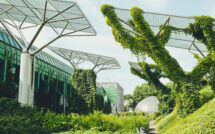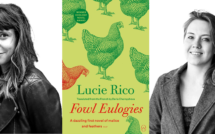

Course description
This course aims to equip students with interdisciplinary tools for approaching, reading, and comprehending diverse literary spaces and environments. Through the lens of the placemaking concept, the course incorporates literature by international authors on cultural heritage places and otherness as well as readings on the relationship between space and place and on how these two concepts inform aesthetics, culture, and literature. Exploring how urban planning, architecture, and the neighborhood are portrayed in literature is important to understand the cultural and aesthetic nature of literary works. Imagology is a branch of comparative literature concerned with cross-national perceptions that focuses on how writers incorporate into their work images of the “Other” and the places and spaces in which this Other lives, thereby exposing cultural images, stereotypes, and imaginary spaces. Analyzing the way place and space are treated in literature offers a valuable standpoint from which to understand the roots and the culture of social structures. The course uses several approaches such as geocriticism, geopoetics, and ecocriticism, which bring different frameworks for the understanding of spatiality in literature. Literary geography and mapping allow for an investigation of the ways in which writers relate to scenery in the physical world. The spatial theory of post-colonialism highlights the way marginalized communities claim city spaces.
During the semester, students explore a wide range of literary texts and theoretical perspectives to gain a deeper understanding of the intricate connection between literature, space, and society in urban narratives that explore urban aspects and city life, with a focus on diversity, culture, people, and architecture. Student are able to enhance their critical reading skills and their analytical and research skills through class discussions, presentations, and written assignments. By integrating imagological studies with the analysis of place and space in literature, students are empowered to critically engage with literary texts, urban environments, and cultural representations. This interdisciplinary approach not only enhances students’ literary appreciation but also fosters their capacity for critical thinking, cultural empathy, and civic engagement in an increasingly interconnected world.
Intended learning outcomes
- Students will develop a comprehensive understanding of literary spaces and environments through interdisciplinary perspectives, integrating insights from sociology, anthropology, geography, and architecture into literary studies and digital cultures.
- Students will become familiar with cultural heritage preservation practices across Europe.
- Students will enhance their critical analysis skills by scrutinizing how texts depict cultural, national, and urban identities and by exploring the construction of place-based imagery, stereotypes, and archetypes in literature.
- Through imagological analysis and comparative studies across cultures, students will cultivate cultural empathy, gaining insight into diverse urban imaginaries and the significance of spatial dimensions in literary narratives.
Course grade components
Class participation (20%): Participation includes classroom interactions such as discussions about the interpretation of literary texts, the choice of theoretical standpoints, and the interdisciplinarity of approaches that emerge in the literature regarding urban spaces and environments. Participation will count in the evaluation of students’ performance.
Written assignments (40%): Writing assignments will be a required component of this course. Students must demonstrate progress in how they utilize spatial theory, cultural representation, and urban narratives to clarify literary content.
Final project (40%): The final project is the culmination of the course. It captures what students have learned during the semester. The final project may pertain to the ways in which cityscapes intervene in literature Projects can take the form of concrete creative projects or research papers and may incorporate insights not only from critical studies but also from other interdisciplinary fields. Students’ final papers should demonstrate that they can write about complex thoughts, conduct independent research, and present their findings clearly to an audience.
Introduction to urban narratives
Urban places have been a source of inspiration for literary writers, who connect communities and make them understand their own identities and history. In this sense, literary writers can provide insight about urban space. By using diverse theoretical perspectives to understand how place and space are interpreted in literature, it is possible to unveil rich meanings underlying the texts at stake and their cultural context.
- Overview of the course themes and objectives.
- Discussion of the significance of urban spaces in literature.
- Introduction to key concepts and theoretical frameworks, including Gaston Bachelard’s The Poetics of Space and Michel Foucault’s Of Other Spaces, Heterotopias.
Readings
- Ulysses by James Joyce
- The Metamorphosis by Franz Kafka.
Mapping urban space: GIS, literary apps
This lecture delves into the intersection of technology and literature, focusing on how Geographic Information Systems (GIS) and literary apps shape our perception of urban environments. Digital literature intertwines with literary tourism, using apps and QR code readers to connect readers with places that inspired authors and blending literature, history, and travel.
- Examination of Alves and Queiroz’s study on studying urban space and literary representations using GIS.
- Discussion of how technology influences our understanding of urban environments in literature.
- Analysis of spatial representations in literary texts.
- Exploration of literary apps.
Readings
- City of Glass by Paul Auster
- Invisible Cities by Italo Calvino
- The Waste Land by T.S. Eliot
- Araby by James Joyce (to explore the theme of urban environments shaping character perception).
Chronotopes in literature: Bakhtin’s historical poetics
By incorporating artistic time and space, the authors provide a detailed description of their imaginary environment, which helps readers to sense, understand, and coopt the energy of the city. To reveal this connection, Mikhail Bakhtin (1981, p. 84), inspired by Albert Einstein’s theory of relativity, introduced the concept of chronotope to indicate the “intrinsic connectiveness of temporal and spatial relations that are artistically expressed in literature.” Although Bakhtin borrowed the idea from Immanuel Kant, he employs the notions of time and space as fundamental frameworks for understanding cognition. But he diverges from Kant by applying these concepts to analyze literary genres, focusing on immediate realities rather than adopting a “transcendental” perspective.
- Exploration of Mikhail Bakhtin’s concept of the chronotope in the novel.
- Analysis of how time-space configurations shape narrative structure and meaning in urban literature.
- Examination of selected literary texts through a Bakhtinian lens.
Readings
- Dubliners by James Joyce
- The Library of Babel by Jorge Luis Borges (to examine the concept of infinite urban spaces)
- Our Town by Thornton Wilder
- The Garden Party and Other Stories by Katherine Mansfield
The death of the author and urban texts
Semiotics, or the study of signs, symbols, and their interpretation, has been concerned with cultural phenomena since Roland Barthes’ work in the 1950s, and it has concentrated on the connotative mechanisms that are formed around every day myths, manifestations of power, and ideology. “Human space,” according to Barthes (1988), is the ultimate signifying space; it refers to the social, cultural, and psychological dimensions of human existence. Urban space may impose a writing style on authors, but it also may be constructed and defined in collective memory through the imaginative discourse of different authors. This lecture aims at exploring how Barthes’ deconstruction of authorial authority reshapes our understanding of urban narratives. By discussing reader response and the intertextuality of urban texts, we unravel the complex relationships between author, text, and reader, offering new insights into the fluidity of meaning and interpretation in the literary urban landscape.
- Analysis of Roland Barthes’ essay The Death of the Author” and discussion of its implications for urban literature.
- Discussion of authorial authority, reader response, and intertextuality in urban narratives.
- Application of Barthes’ ideas to selected urban texts: City of Glass by Paul Auster, Our Town by Thornton Wilder, The Garden Party by Katherine Mansfield (to analyze the role of the author in shaping urban narratives).
Semiology and urbanism: reading cities as texts
This seminar delves into Roland Barthes’ work, “Semiology and Urbanism,” exploring its profound insights into the cultural significance of urban spaces. Through analysis, we decipher the semiotics embedded within urban environments, treating cities as complex texts ripe for interpretation. By examining how literature portrays and interprets urban landscapes, we uncover the layers of meaning and symbolism inherent in the built environment, offering new perspectives on the relationship between culture, space, and society.
- Examination of Roland Barthes’ “Semiology and Urbanism” and its insights into the cultural meaning of urban spaces.
- Analysis of the semiotics of urban environments in literature.
- Discussion of how cities are represented and interpreted in literary texts: Underworld by Don DeLillo, “Howl” by Allen Ginsberg, City of Glass: The Graphic Novel by Paul Auster and David Mazzucchelli (to explore visual semiotics in urban narratives).
Imagology and the cultural construction of urban identities
As imagology studies the portraying of national, cultural, and urban identity in literature, it reveals how texts create and keep images of places and spaces. When examining placemaking through an imagological lens, one can learn about cultural representations, stereotypes and archetypes, identity and alterity, sense of belonging, the hegemony of power and perception. It is also possible to understand the complex interplay between culture, literature, art, and the creation of meaningful places in our world. Students are encouraged to explore how places are described, portrayed, and understood in literature. They are also encouraged to develop critical thinking when examining how their own heritage is portrayed in different forms of cultural expression and how this representation relates to their personal experiences. Unveiling the stereotypes and archetypes that are associated with particular places reveals how these places are constructed in the collective imagination. Indeed, the placemaking concept is deeply intertwined with the identity and culture of a specific community. Approaching a literary text from an imagological angle reveals how the representation of a place contributes to the identity and sense of belonging of the people who inhabit it and how that identification is influenced by cultural narratives.
- Introduction to the concept of imagology and its relevance to urban literature.
- Analysis of how national characters are constructed and represented in urban narratives.
- Exploration of selected urban-focused texts through an imagological lens.
Readings
- The Brief Wondrous Life of Oscar Wao by Junot Díaz
- Americanah by Chimamanda Ngozi Adichie
- Interpreter of Maladies by Jhumpa Lahiri
- “Selected Poems” by Langston Hughes (to examine the construction of urban identities across cultures).
Literature, translation, and imagology
This lecture will explore the relationship between translation studies and imagology and how they work together to shape cultural portrayals of urban spaces in literature. Translation serves as a bridge between cultures, shaping the perception and representation of urban landscapes within literary works. We will discuss and analyze the transformative power of translation and how it can convey cultural nuances and identities within literary landscapes.
- Examination of the intersection between translation studies and imagology.
- Discussion of how translation influences the cultural representation of urban spaces in literature.
- Analysis of translated urban texts and their implications for imagological research.
Readings
- The Library of Babel by Jorge Luis Borges, Open City by Teju Cole
- The Shadow of the Wind by Carlos Ruiz Zafón,
- Selected Poems by Pablo Neruda
- A Streetcar Named Desire by Tennessee Williams (to explore cultural translations of urban experiences)
- Other Destinations. Translating the Mid-sized European City by Michael G. Kelly, Mejía Hernández, Jorge, Novak, Sonja and Giuseppe Resta.
New perspectives on urban imagology
- Exploration of recent developments in imagology and their application to the study of urban literature.
- Analysis of emerging themes and methodologies in imagological research.
- Discussion of the future directions of urban imagology.
Readings
- NW by Zadie Smith
- Paterson by William Carlos Williams (to uncover how urban settings shape narrative landscapes, offering fresh insights into the study of literature and the city.)
Geopoetics and literary cartographies
Geopoetics—a term coined by Kenneth White—shows the relation between the biogenetic sphere, poetry, and culture to offer a particular perspective in the study of the relation between literature and environment. Our aim in this course will be to examine and debate on how literature serves as a graphic tool that subsidies the construction of an image of the city, also examining how this construction process erases geographical borders to disclose the deep meanings emerging how of urbanized land. Through the study of literary cartographies, we will reflect on how literature creates certain pictures of cities and the ways in which humans and environments interplay in analogue or digital space.
- Introduction to geopoetics and its relevance to the study of urban narratives.
- Examination of how literature maps reimagine urban spaces.
- Analysis of selected urban texts through a geopoetic lens
Readings
- White Teeth by Zadie Smith or
- Neapolitan Novels series by Elena Ferrante.
Time, narrative, and space: Ricœur’s philosophical inquiry
This lecture examines Paul Ricœur’s deep philosophical question about the use of time in narratives. We shall consider the implications of the relationship between time and narrative in the development of stories about urban spaces. Additionally, we will analyze and discuss how narrative structures affect our understanding of the details of urban environments.
- Exploration of Paul Ricœur’s philosophical inquiry into time and narrative.
- Analysis of how narrative structures shape our understanding of urban spaces.
- Examination of selected literary texts through a Ricœurian lens.
Readings
- Beloved by Toni Morrison
- The Lottery by Shirley Jackson (to examine the intersection of time, narrative, and urban ritual)
- Underworld by Don DeLillo
- The Brief Wondrous Life of Oscar Wao by Junot Díaz.
Reading the urban environment: perception theories and visual communication
To explore how visual communication shapes our comprehension of urban spaces as portrayed in literature, we will examine the intricate relationship between literature, perception, and the built environment as portrayed in urban narratives. The selected works serve as case studies for analyzing the visual communication and literary representations of urban landscape and narratives.
- Analysis of Silva Gouveia et al.’s study on reading the urban environment with perception theories.
- Discussion of how visual communication shapes our understanding of urban spaces in literature.
- Exploration of the relationship between literature, perception, and the built environment in urban narratives.
Readings
- In the Skin of a Lion by Michael Ondaatje
- The Garden Party and Other Stories by Katherine Mansfield
- Americanah by Chimamanda Ngozi Adichie
- Watchmen by Alan Moore and Dave Gibbons (to analyze the visual communication of urban narratives).
Urban identities: migration, multiculturalism, and postcolonial perspectives
We will analyze postcolonial literature’s intricate representation of migration, diaspora, and cultural diversity within urban landscapes, probing colonial legacies and the complexities of cultural hybridity. Additionally, we will discuss the intersections of multiple identities, power dynamics, and identity formation in the city.
- Exploration of literature’s representation of migration, diaspora, and cultural diversity in urban contexts.
- Analysis of postcolonial literature’s engagement with urban spaces, interrogating colonial legacies and cultural hybridity.
- Discussion of the intersections of multiple identities, power dynamics, and identity formation in the city.
Readings
- The Catcher in the Rye by J.D. Salinger
- Never Let Me Go by Kazuo Ishiguro
- The Underground Railroad by Colson Whitehead
Imagining urban futures: dystopia, gender, and social commentary
The works selected for this lecture serve as catalysts for probing into the ways in which dystopia, gender, and urban life intersect. We will dissect texts foregrounding women’s perspectives on urban life, delving into gendered experiences, safety, mobility, and belonging in urban environments. Furthermore, we will engage in a discussion of dystopian literature’s searing critique of social, political, and environmental issues, exploring its implications for urban futures.
- Examination of dystopian and speculative fiction’s portrayal of urban landscapes and social commentary.
- Analysis of texts foregrounding women’s perspectives on urban life, exploring gendered experiences, safety, mobility, and belonging in urban environments.
- Discussion of dystopian literature’s critique of social, political, and environmental issues, and its implications for urban futures.
Readings
- The Road by Cormac McCarthy
- Brave New World by Aldous Huxley
- The Handmaid’s Tale by Margaret Atwood
Literary landscapes: analyzing cities and literature
The exploration of the complex and varied representations of cities in literature helps better understand how cities become active contributors to the stories they appear in, bridging the link between urban environments, memory, and narration plot. Through both textual and visual representations of urban landscapes, we will examine the layers of meaning cities’ streets and skylines hold.
- Exploration of the representation of urban landscapes in literature.
- Analysis of how cities function as characters and settings in literary texts.
- Discussion of the relationship between urban environments, memory, and narrative structure.
Readings
- Istanbul: Memories and the City by Omar Pamuk
- The Cairo Trilogy by Naguib Mahfouz
- Midnight’s Children by Salman Rushdie
- The Collected Poems of Langston Hughes by Langston Hughes
- City of Glass: The Graphic Novel by Paul Auster and David Mazzucchelli (to explore visual representations of urban landscapes).
Onorina Botezat (BA in philology and law, MA in law, PhD in theory of literature) is an Associate Professor in French and English at the Bucharest University of Economic Studies, Romania. Her areas of research include travel writings and cultural transfer, imagological and literary studies, and legal terminology. Her most recent publications are Mapping Cultural Identities and Intersections: Imagological Readings (edited with Mustafa Kirca, Cambridge Scholars Publishing, 2019) and Romanian Authors Writing in Foreign Tongues (edited with Corinne Fournier Kiss, Ramona Mihăilă, Pro Universitaria, 2021).
References
Alves, Daniel, and Ana Isabel Queiroz (2013). “Studying Urban Space and Literary Representations Using GIS: Lisbon, Portugal, 1852-2009.” Social Science History, 37(4), 457–481. doi:10.1017/S0145553200011937
Bachelard, Gaston. (1994). The Poetics of Space. Trans. from the French by Maria Jolas, with a foreword by John R. Stilgoe. Boston: Beacon Press.
Bakhtin, Mikhail Mikhailovich. (1981). “Forms of Time and of the Chronotope in the Novel: Notes toward a Historical Poetics.” In Holquist, Michael (ed.). The Dialogic Imagination: Four Essays. Slavic Series, NO. 1. Translated by Emerson, Caryl. Austin, Texas, USA: University of Texas Press. pp. 84–85.
Barthes, Roland. (1977). “The death of the author” Image, music, text. (trans. S. Heath), London: Fontana.
Barthes, Roland. (1988). “Semiology and Urbanism.” The Semiotic Challenge, translated by Richard Howard. Oxford: Basil Blackwell, pp191-201.
Foucault, Michel. (1984). “Of Other Spaces, Heterotopias.” Translated from French by Jay Miskowiec. Architecture, Mouvement, Continuité, 5: 46-49.
Kelly, Michael G., Mejía Hernández, Jorge, Novak, Sonja and Giuseppe Resta (2023). Other Destinations. Translating the Mid-sized European City. Osijek: Faculty of Humanities and Social Sciences University of Osijek.
Ricoeur, Paul. (1985). Time and Narrative. Volume 2. Translated by Kathleen McLaughlin and David Pellauer. Chicago: The University of Chicago.
Silva Gouveia, A. P., Lena Farias, P., & Souza Gatto, P. (2009). “Letters and cities: reading the urban environment with the help of perception theories.” Visual Communication, 8(3), 339-348. https://doi.org/10.1177/1470357209106474
White, Kenneth. An Outline of Geopoetics. https://www.institut-geopoetique.org/en/articles-en/37-an-outline-of-geopoetics
Published on June 17, 2024.




